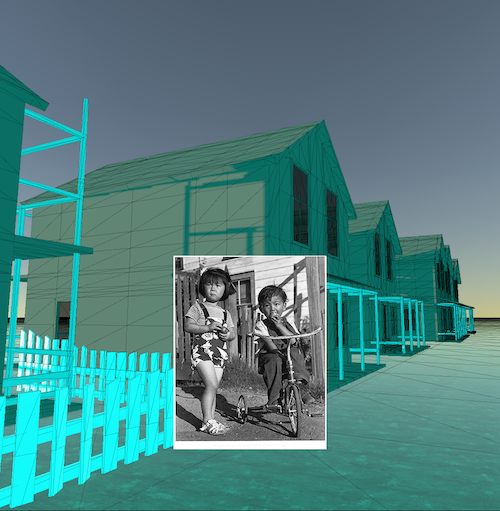Campus News
Susana Ruiz receives Hewlett 50 Arts Commission for a new media work focused on Santa Cruz’s lost Chinatowns
Susana Ruiz, UC Santa Cruz Assistant Professor of Film and Digital Media, together with Emmy Award nominated director of photography and media artist Huy Truong have been selected as one of ten recipients of this year’s Hewlett 50 Arts Commissions in Media Arts.

Susana Ruiz, UC Santa Cruz Assistant Professor of Film and Digital Media, together with Emmy Award nominated director of photography and media artist Huy Truong have been selected as one of ten recipients of this year’s Hewlett 50 Arts Commissions in Media Arts. The prestigious grant from the William and Flora Hewlett Foundation will fund the creation of a new media work related to the history of Santa Cruz’s Chinatowns. The piece, presented by The Santa Cruz Museum of Art & History (MAH) and also supported by the Arts Research Institute at UCSC, will make its debut in 2024.
“The Last Chinatown” (working title) is an interactive public memorial and augmented reality film. Through the lens of historical erasure, the work speaks to the rich narrative landscape of Santa Cruz with a focus on its last Chinatown. It is a performative interpretation of an original story by author and UCSC Professor Emerita of Literature Karen Tei Yamashita supported with insights from community members and historical documents. The final work will incorporate theater and gameplay and will be experienced on mobile devices, including augmented reality glasses, at historically important sites in downtown Santa Cruz to render visible the lives, legacies, and labors of those who lived there.
Santa Cruz had four distinct Chinatowns throughout the late 19th and early 20th centuries. Chinese immigrants, who were fundamental in building California’s infrastructure and furthering its economy, were confined to the limits of these Chinatowns, where they often shared space with other individuals who had been marginalized by the infrastructures of white supremacy. They were precarious sites subject to repeated floods and fires. Santa Cruz’s last Chinatown, located in present-day downtown just two blocks from the MAH, was swept away by the overflowing San Lorenzo River on Christmas night 1955.
Ruiz and Truong, who have long had an interest in the erased histories of BIPOC communities in Santa Cruz, were unaware of the existence of the city’s Chinatowns until they attended a 2018 performance by dancer, choreographer, and UCSC Professor of Performance, Play & Design Cynthia Ling Lee in which she embodied characters spanning a century of Chinese presence in the area.
Ruiz and Truong were shocked. “How could there be no remnants of these neighborhoods in this progressive community?” says Ruiz. “They were invisible completely. But our archival research made us very intrigued by these communities. These Chinatowns were a place for many BIPOC people.”
The duo’s research led them to a number of history-makers and leaders in the Santa Cruz AAPI community, including George Ow Jr., an elder and one of the last residents with memories of living in the last Chinatown. Ow’s vivid stories offered tantalizing opportunities to use AR technology to place people physically in the past.
“George’s grandmother had a large garden next to the river,” says Truong. “Participants will be able to stand next to the river on that spot—with the sound of the water, the smell of the plants, and the wind on their skin—and experience his story through AR and volumetric filmmaking in the actual space. It’s so immersive and compelling.”
“We are both media artists,” adds Ruiz. “We are intrigued by technologies that allow us to tell stories in a new way. Most of the ways we experience stories don’t ask us to think about our bodies in the space. The physicality is such a strong component of the work. We’re so excited to be working with Karen Tei Yamashita to bring story, history, embodiment, and space to life.”
Ruiz and Truong, who is also a former Lecturer in Film and Digital Media at UCSC, have long partnered artistically. They are founding partners, with documentary filmmaker Ashley York, of the multiple award-winning Take Action Games (TAG), an artist’s studio with a portfolio traversing games, art, justice activism, and storytelling. Their work has garnered multiple accolades. TAG’s game “Darfur is Dying” earned the studio the prestigious Governor’s Award (the Emmy’s highest honor) at the 2006 Academy of Television Arts & Sciences Emmys as a core component of the MTV transmedia campaign in Sudan and was presented to members of the U.S. Congress in the United States Capitol during the National Online Town Hall Meeting on Darfur. TAG’s “RePlay: Finding Zoe/ReJouer: Où est Zoé?” was honored with the Adobe 2009 MAX Award for Social Responsibility and was included in a United Nations report titled “The Global Assessment on Women’s Safety” as an exemplar of an innovative partnership between a social justice organization and a media developer.
In contrast to these globally-focused projects, “The Last Chinatown” is, for Ruiz and Truong, an opportunity to delve into something close to home. “As an Asian-American, there’s a special place that Chinatown holds for a lot of us growing up,” says Truong, who lived many years in New York City’s Chinatown. “It’s a space for people of color … where you can be comfortable in your own skin.”
“The Last Chinatown” is slated for a public premiere in the spring of 2024, with a preview of the work scheduled to be shown at the MAH’s “Frequency” digital arts festival from September 21-24, 2023.